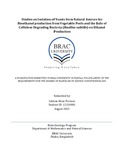| dc.contributor.advisor | Hossain, M Mahboob | |
| dc.contributor.author | Promon, Salman Khan | |
| dc.date.accessioned | 2015-09-03T06:26:14Z | |
| dc.date.available | 2015-09-03T06:26:14Z | |
| dc.date.copyright | 2015 | |
| dc.date.issued | 2015-08 | |
| dc.identifier.other | ID 12136001 | |
| dc.identifier.uri | http://hdl.handle.net/10361/4370 | |
| dc.description | This thesis report is submitted in partial fulfillment of the requirement for the degree of Bachelor of Science in Biotechnology, 2015. | en_US |
| dc.description | Cataloged from PDF version of thesis. | |
| dc.description | Includes bibliographical references (page 61 - 68). | |
| dc.description.abstract | The requirement of an alternative clean energy source is increasing with the elevating energy demand of modern age. Microbial production of bioethanol can replace the conventional fossil fuel with green energy. In this study, local yeast isolates were used for the production of bioethanol using cellulosic vegetable wastes as substrate. This project were designed for the efficient bioconversion of lignocellulosic biomass into ethanol by microbial action. Wild-type yeast isolated form sugarcane juice (SC1) and date juice (DJ1) were used as ethanol producing organism. After proper isolation, identification and characterization of stress tolerance (thermo-, ethanol-, pH-, osmo- & sugar tolerance), detailed characterization and optimization of physiochemical parameters for ethanol production the strain is treating to be dubbed as an industrial strain. Very inexpensive and easily available raw materials (vegetable peel kitchen wastes) are used as fermentation media. The overall objective of this project is to meet the demand for an inexpensive and highly efficient integrated anaerobic Saccharomyces spp. fermentation process to produce ethanol as an energy source directly from insoluble lignocellulosic substrate (kitchen-waste). Fermentation was optimized with respect to temperature, reducing sugar concentration and pH. Analysis of fermentation characteristics under different substrate and environmental conditions, it was observed that temperature of 30°C and pH 6.0 were optimum for fermentation with maximum yield of ethanol. Influence of Bacillus subtilis increased the alcohol production rate from the fermentation of cellulosic materials. The cellulolytic activity of this cellulose degrading bacteria converts cellulose into smaller sugars which will be easier to be fermented by yeast. Maximum ethanol production by yeast was 17.39% using vegetable peels as substrate at 48 hours (30°C and substrate was treated with Bacillus subtilis) under shaking condition. | en_US |
| dc.description.statementofresponsibility | Salman Khan Promon | |
| dc.format.extent | 70 pages | |
| dc.language.iso | en | en_US |
| dc.publisher | BRAC University | en_US |
| dc.rights | BRAC University thesis are protected by copyright. They may be viewed from this source for any purpose, but reproduction or distribution in any format is prohibited without written permission. | |
| dc.subject | Biotechnology | en_US |
| dc.subject | Bioethanol | en_US |
| dc.subject | Cellulase mediated | en_US |
| dc.subject | Bacillus subtilis | en_US |
| dc.subject | Ethanol | en_US |
| dc.title | Studies on isolation of yeasts from natural sources for bioethanol production from vegetable peels and the role of cellulose degrading bacteria (Bacillus subtilis) on ethanol production | en_US |
| dc.type | Thesis | en_US |
| dc.contributor.department | Department of Mathematical and Natural Science, BRAC University | |
| dc.description.degree | B. Biotechnology | |

